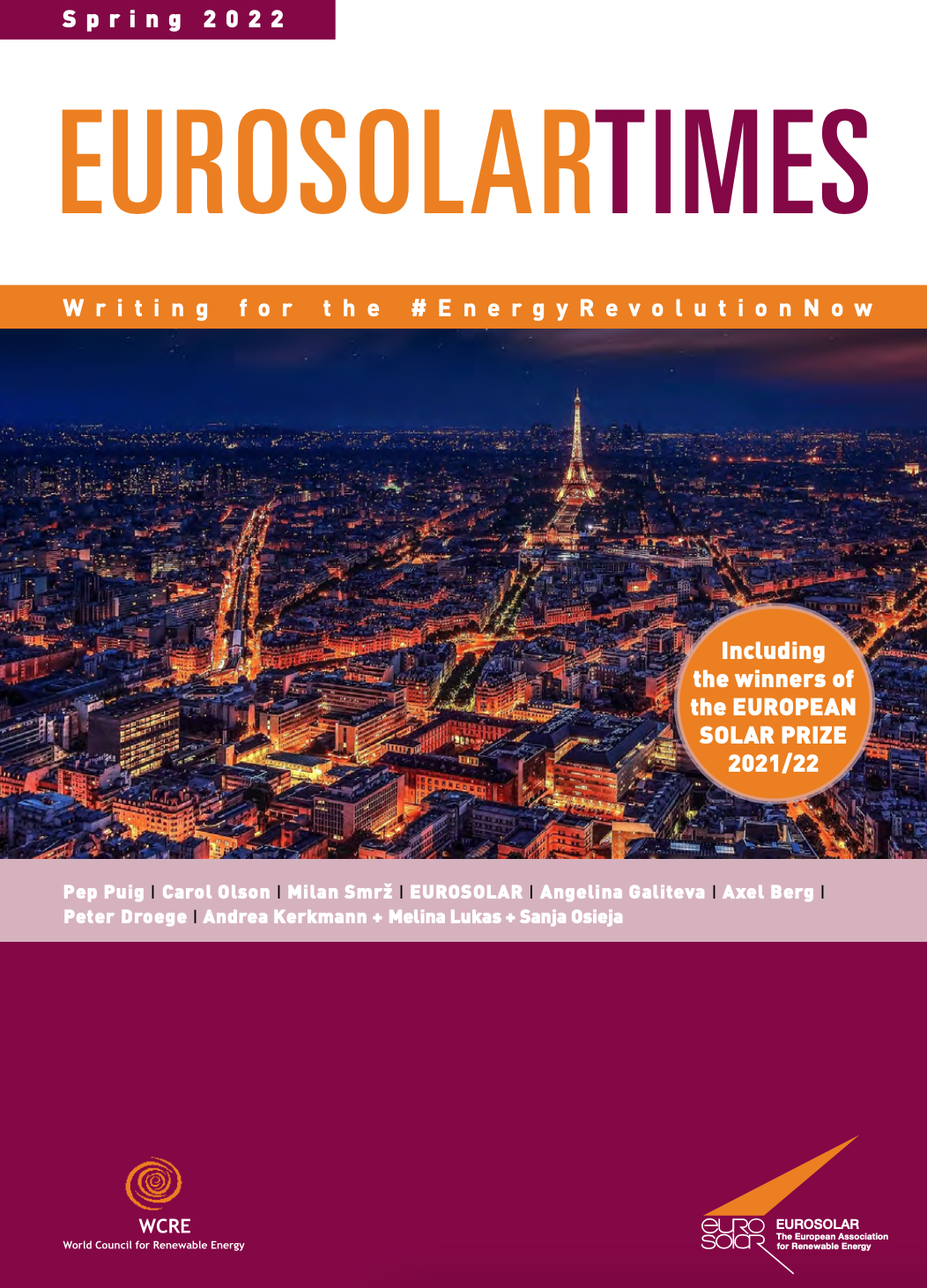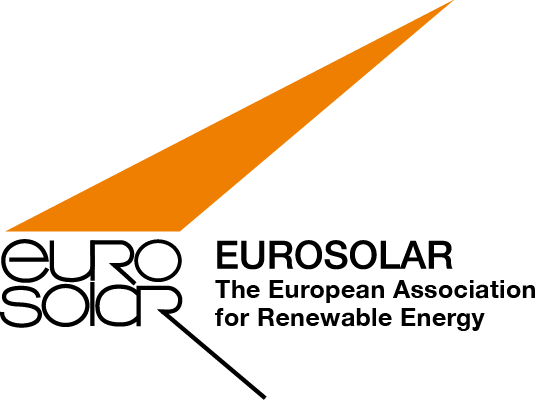By Peter Droege.
The great carbon bubble on which our civilization, its economies and our cities has risen for the past 200 years represents one of the most massive, radical and abrupt disruptions in the known history of this planet – surpassing even those caused by all previous extinction events. Sloganed programs such as the European Green Deal (EGD) respond far too little to the fact that without massive concerted action, this bubble has an existential inevitability.
The measures proposed in the EGD need to be tightened and rethought to go beyond the Deal – recognizing that the goal is not to create one last dubious win-win, but to avoid the big loss. It is in cities, in particular, that this proposed NCS agenda – the negative-carbon society – can and must become concrete, specific, and tangible. Only a renewable energy-based European economy that lowers atmospheric carbon concentrations can provide the foundation for the urban regenerative society that urgently needs to be created.
Calculational neutralization – the false dream of net zero – is not enough. Only by a) eliminating emissions and b) reversing the flow of greenhouse gas emissions from construction, building – cement and other materials – and food chains and webs – across agriculture, processing and consumption can we begin to correct the direction of the emissions vector – in other words, reverse it. As cities and their political institutions play an important role in this transformation, they must be given more knowledge, technical and financial support in their efforts to address this major disaster.
The local, national, and global diffusion of the principles underlying the documented initiatives has long since become critical – without sufficient adjustments to the current policy, regulatory, and market frameworks. To articulate the need for action, we propose what I call a Regenerative Cities Protocol (RCP), a set of paradigms and principles that support the regeneration of cities and regions and the full transition to renewable energy. It also supports government guidelines for individual, community, industrial, and research innovation in the adoption of carbon sequestering building and manufacturing practices. Promoting biodiversity is now fundamentally a core responsibility of urban and regional planning. European cities and urban communities are challenged to promote more environmentally responsible and conscious lifestyle choices and consumption patterns, including integrated urban and peri-urban ecological and carbon-negative agricultural supply systems.
EUROSOLAR Times Spring 2022
Read this and more interesting articles on the energy transition in our publication EUROSOLAR Times.

This is a call to Europe, its member states and cities – as well as regions, nations and cities in other countries to rise up and support fundamental changes in the economy, institutions and governance. This is the only way to systematically replace legacy energy systems with decentralized renewable energy infrastructures based on new technologies and community benefits – a fundamental prerequisite for a comprehensive program to reduce carbon pollution in the atmosphere. It is also critical to find ways to regenerate and retrofit existing neighborhoods and their building stock that result in excess renewable energy production and concurrent negative carbon flows. Other priority policy goals include investing in the conversion of agriculture and forestry to renewable energy, carbon sequestration in buildings and industry, and the rapid phase-out of coal, natural gas, and oil.
The European directives on the circular economy create a good starting position to become the basis and driver of a carbon-negative economy. At the moment, it is still a weak and little-used management tool: only a tiny fraction of the resource stream in the EU is reused or recycled.
However, circular economy processes need to be strengthened in ways that ensure that agricultural, construction, road infrastructure, energy, and industrial processes become carbon sinks, in part in the form of sustainable wood use or other carbon-rich materials extracted from the atmosphere, such as carbon fiber derived from algae. At the same time, fundamentally flawed technologies such as nuclear power, natural gas as “transition energy“, “clean coal“, and carbon capture and storage (CCS) – a technology that is not only costly but also technologically troubling and impractical – must be vigorously avoided.
This set concerns the development of the 10-point plan devised for the Regenerative Earth Decade Action Framework and its Exchange Platform. Ten policy and action points form the basis of this thematic set:
1. Climate Defence Budgets
A central vision involves the introduction of national climate defense budgets for the rapid phase-out of fossil fuels and a switch to renewable energies – this may account for five to ten percent of the gross national product – equivalent to four to eight times average military budgets in need of redirection and repurposing to climate defence action.
2. Climate Peace Diplomacy
It introduces the concept of climate emergency diplomacy, that of ending wars and acts of war, in the common interest in the fight for survival – against the common enemy of global warming. See www.climateforpeace.org for the basic concept. Climate diplomacy includes climate migration management plans: billions of fellow human beings will be forced to migrate very soon: the business-as-usual RCP8.5 / three degree Kelvin meant average temperature rise scenario implies that up to one third of the world’s population may have to migrate over the next 50 years.
3. Fossil Fuel Industry Restructuring
Fossil fuels are on their way out – but the influence and inertia of incumbent industries has meant a very slow transition. The targeted restructuring of fossil industries is needed: through technical substitution programs, the elimination of structural subsidies and, where necessary, structural measures such as transformation assistance. This complex includes also the immediate dismantling of the massive regulatory blocking of renewable energy grids, storage and distribution systems – supported by new energy market frameworks.
4. Regenerative Employment Programs
The major aim is the replacement of jobs in the fossil industries by prioritized structural reforms towards renewable industries. By structuring opportunities in renewable energy oriented retraining, research, development, manufacturing, maintenance, investment and policy development we can not only ease the transition of workers, job opportunities but also dramatically boost the sheer number of available jobs.
5. Redefinition of Emission Targets
Climate neutrality is not enough, but even so-called zero emission targets alone are no longer sufficient. The long term stable CO2 level peaked at 280 ppm, current levels will exceed 420 ppm very soon. Long-term stable methane levels were at 600 ppb, current levels may soon exceed 2,000 ppb. Emissions targets are not only set too high – they should be set below zero. The global economy needs strategies that are suitable for reducing greenhouse gas (GHG) concentrations in the atmosphere by reversing the flow of emissions.
6. Source Taxation of Fossil Fuels and their Phasing Out through Prohibition
The classification of fossil resources as toxic: their extraction and distribution should become highly taxed in a short transition period to prohibition. This task examines paths and means to athis based on precedents and routes to success in other area of emission and waste regulation.
7. Biosequestration: the rapid development and regeneration of healthy, climate-active agricultural soils, wetlands and forests
Carbon concentration reduction in the atmosphere requires as one of the most available mechanisms the activation of the natural capacity of healthy soils and natural land cover in drawing down and absorbing and retaining atmospheric carbon.
8. Industrial sequestration: Transformation for Carbon Uptake
The transformation of the construction industry and all industries and manufactories into carbon-sequestration processes demands the large-scale conversion of atmospheric CO2 into wood, carbon fibers and other solid carbon products.
9. Regenerative economic boost benefiting from migrant streams
Taking full advantage of unprecedented productivity and innovation in the new regenerative industrial reality to massively expand prosperity and high-quality employment opportunities for all citizens – and especially for existing and new migrants.
10. A Regenerative Finance Mechanism
Mechanisms are needed that rewards long-term investments such as defossilization, agricultural reform and afforestation with higher returns than short-term ones. This calls, for example, for ‘Future Banks’ that create special currencies with demurrage charges in the form of negative interest rates, thus incentivizing spending tied to sustainable products and services.
Peter Droege is president of EUROSOLAR

